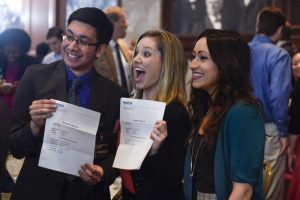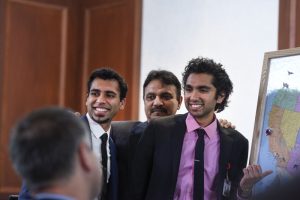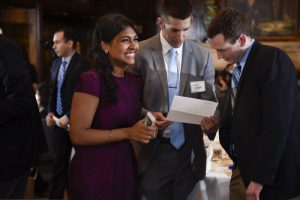National Resident Match Day 2017
On March 17, 2017, 41 seniors from Mayo Clinic School of Medicine learned where they’d spend the next several years of their lives as part of National Resident Match Day. They joined more than 42,000 graduating medical students vying for 30,000 postgraduate medical positions through more than 4,800 residency training programs across the U.S.
Fredric Meyer, M.D. (NS ’87), the Juanita Kious Waugh Executive Dean for Education of the Mayo Clinic College of Medicine and Science and dean of Mayo Clinic School of Medicine, says: “We are extremely proud of these medical students.” He also challenged them to carry forth the altruism, the Mayo values and the patient-centered model of care they learned at Mayo.
Mayo’s medical students have traditionally had highly successful match results. This year 100 percent of Mayo’s students, including three past graduates, matched to their specialties:
- 25% surgical specialties (urology, ophthalmology, neurosurgery, orthopedics, general surgery, plastic surgery)
- 12% psychiatry
- 12% pediatrics
- 10% internal medicine
- 5% anesthesiology
- 5% family medicine
- 5% radiation oncology
- 5% OB/GYN
- 5% military match
- 2.5% neurology
- 2.5% radiology
Geographically, here’s where students matched:
- 24% at Mayo Clinic
- 44% in central U.S.
- 27% eastern U.S.
- 15% southern U.S.
- 29% western U.S.
- 24% in Minnesota
“The continual success of our residency match is a testament to the quality of training provided at Mayo Clinic, says Steven Rose, M.D. (MED ’81, I ’82, ANES ’84), dean, Mayo Clinic School of Graduate Medical Education. “The highly talented applicants we interview for residencies and fellowships often can choose among the very best training programs in the country. There will also be 302 ecstatic medical students opening their envelopes to find Mayo Clinic as their residency destination.
“When they choose Mayo Clinic, we feel an unwritten promise is established. As an organization and as individuals, we will teach and demonstrate the knowledge, skills, professional behaviors and attitudes that provide a foundation for these young physicians to practice outstanding humanistic patient care. We also provide opportunities to advance medicine and science through discovery, and provide mentorship to develop future leaders in their profession and communities.”
That unwritten promise serves Mayo Clinic well – 79 percent of Mayo’s current physician staff received training through Mayo Clinic School of Graduate Medical Education, and 33 percent of current Mayo Clinic consultants on staff received their medical training through Mayo Clinic School of Medicine.
Learn more about some of these bright future Mayo Clinic alumni — where they’ve been, where they’re headed and what motivates them.



